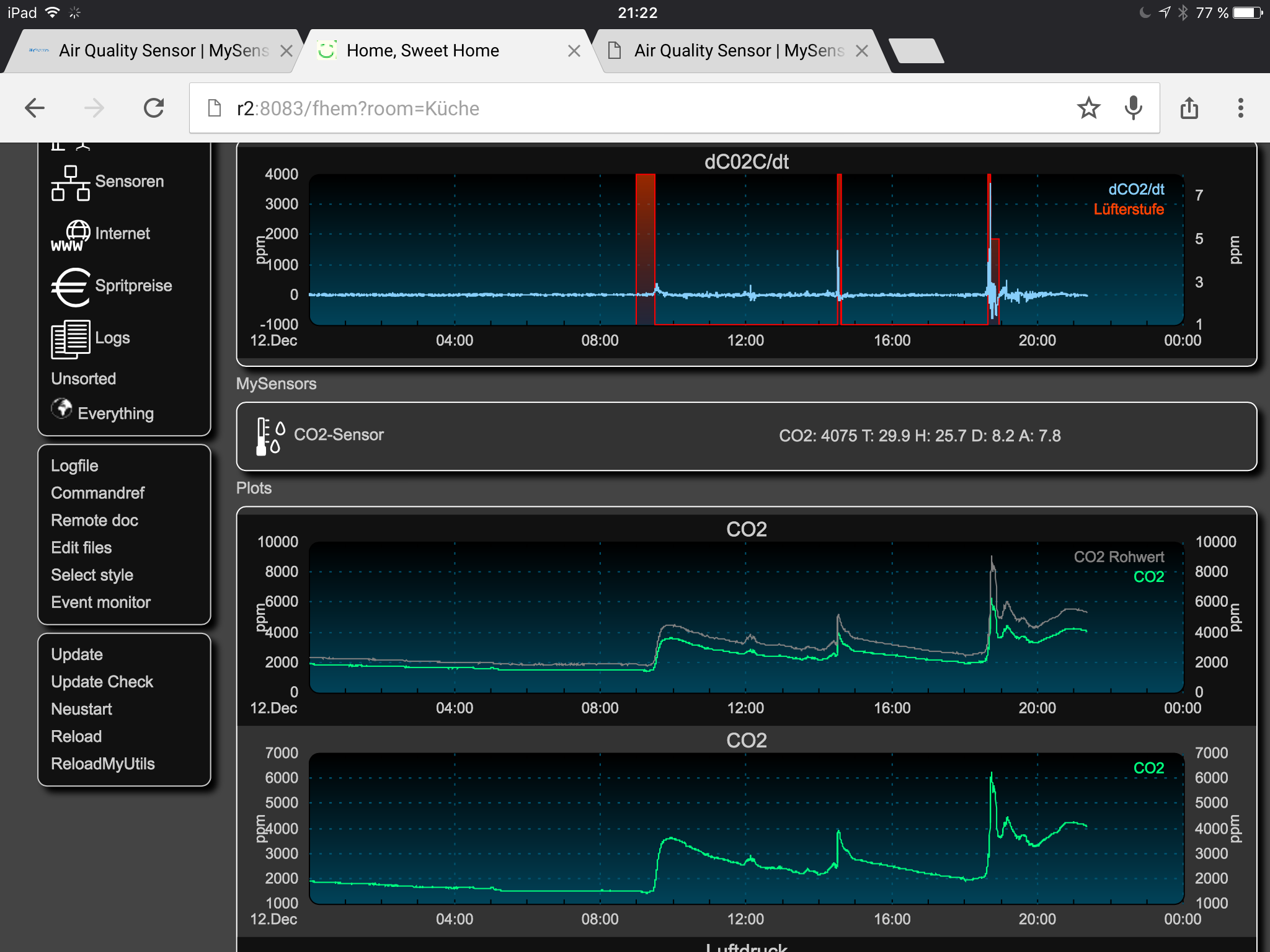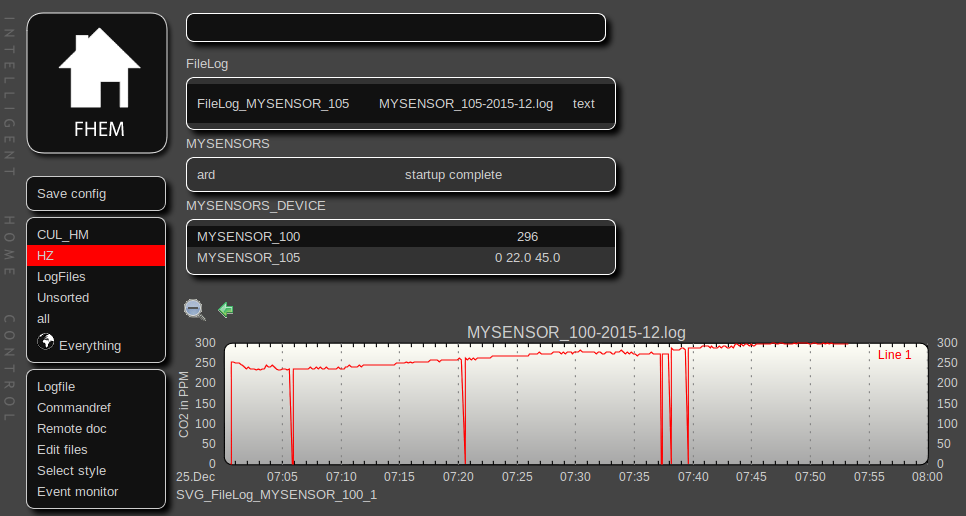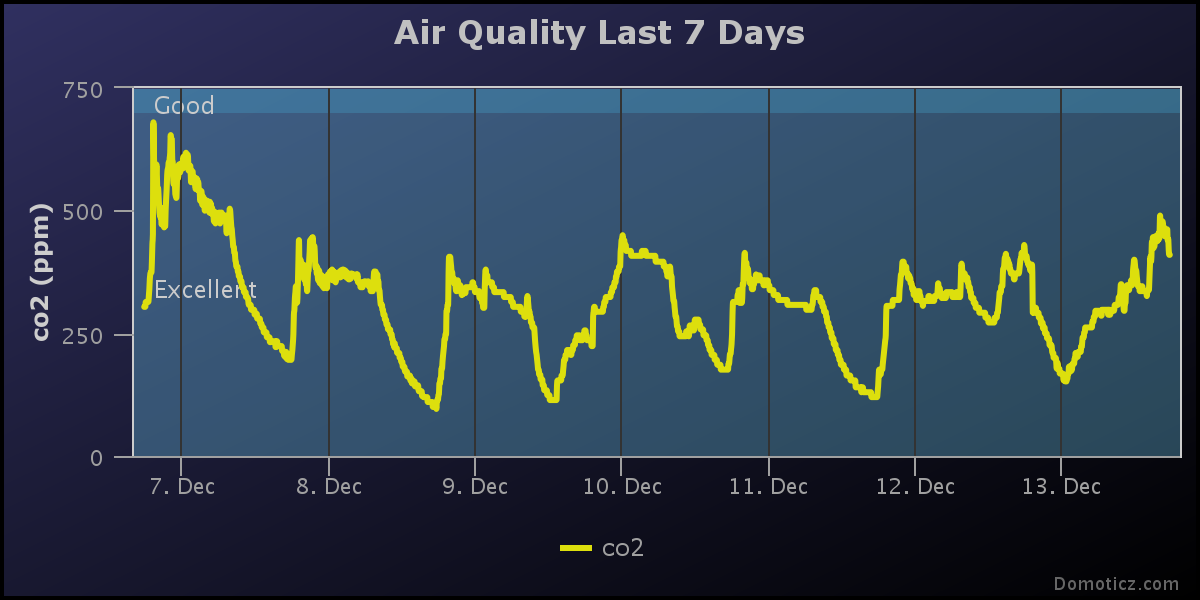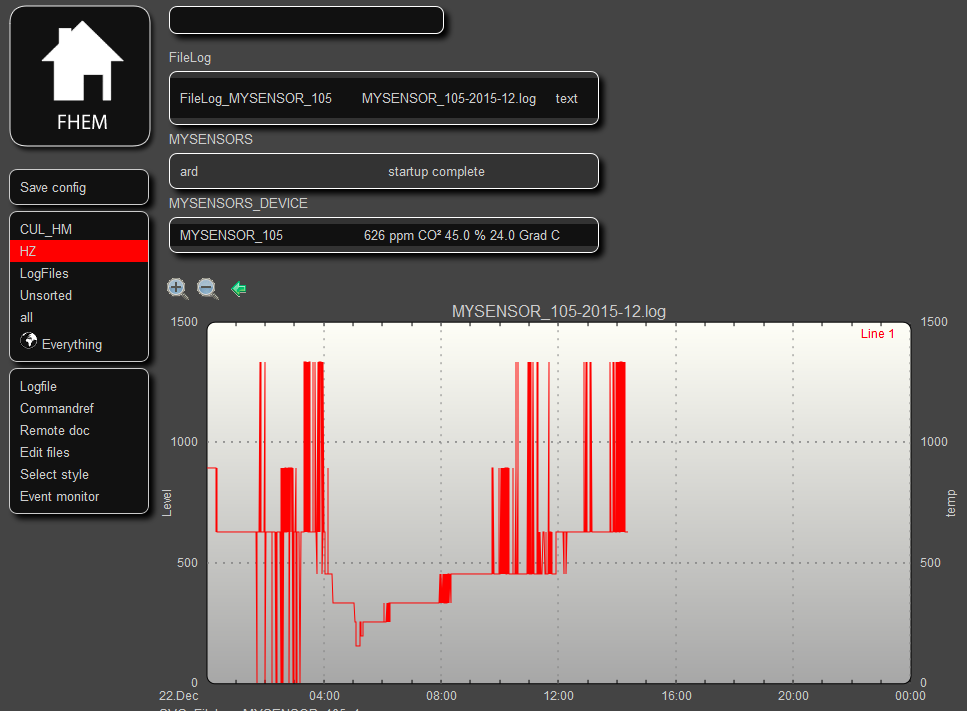Air Quality Sensor
-
The sensor is in my kitchen. The value in the screenshot is very high as I made some french fries 2 hours ago.

-
IN MiCS 2614 , sensitivity factor is defined by "Rs at 100 ppb of O3 divided by Rs at 50 ppb of O3". From where you measured Rs at 100 ppb or 50 ppb.???
@bhavika said:
IN MiCS 2614 , sensitivity factor is defined by "Rs at 100 ppb of O3 divided by Rs at 50 ppb of O3". From where you measured Rs at 100 ppb or 50 ppb.???
this is just to tell you how much a double concentration scales up, here they just say it is somehow linear at ratio 2
-
@Heinz very nice work :+1: (wie heisst du im FHEM Forum?)
Does someone have the values a MQ-07 needs to perform properly? I rally don't know how to gather the right values from the description.... :)
Thank you
-
@Rasenheizung if you base yourself on my template here https://github.com/empierre/arduino/blob/master/AirQuality-Multiple_Gas_Sensor1_4.ino
H2
1.3 50
0.8 100
0.28 400
0.16 1000
0.05 4000y = 73.59123879 x-1.355617483
Residual Sum of Squares: rss = 87393.44418
H2Curve[3] = {73.5912, -1.355617};CO
1.6 50
1 100
0.39 400
0.21 1000
0.09 4000y = 99.27731641 x-1.513643469
Residual Sum of Squares: rss = 43168.87424
COCurve[3] = {99.27731, -1.51364};CO is a dangerous gas, the MQ7 is very sensitive to many things and no calibration too... for a serious work please think about using the MICS-6814 that is calibrated, includes 3 gases out of the box, and is very low consumption (can run on battery !)
https://github.com/empierre/arduino/blob/master/AirQuality-CO-NO2-NH3.ino -
So what is the conditioning period for testing in it??? It is two days.. What does it mean??
@bhavika said:
So what is the conditioning period for testing in it??? It is two days.. What does it mean??
on this kind maybe to have it powered for a full two days to burn out the production "dusts" that may remain in.
those sensors are not good science, see the correlation of gases they are reported for in the datasheet
-
Hello,
a very sensitive HCHO module you can see a demo here: http://www.seeedstudio.com/recipe/379-a-handheld-hcho-detector.html?utm_source=EDM&utm_medium=EDM&utm_campaign=EDM20150930
https://github.com/empierre/arduino/blob/master/AirQuality-HCHO.ino
-
Looks strange, could you supply your code?
Btw the sensor draws a lot of current, the power supply should be able to deliver 1A. Did you burn in the sensor for 12-24 hours? -
I have used the code from epiere. Baking I have not done. I use different power supplies (USB, Samsung and a large controllable power supply). I sometimes feel that contacts do not function properly. But the sensor draws but only about 100 mA = 0.1 A? Then it seems to be on branding. I have three new sensors. Mostly we read that it is only an attempt here is to measure the CO2 content. When I check the values with a measuring instrument with which agree the details here https://olimex.wordpress.com/2015/05/26/experimenting-with-gas-sensors-and-arduino/ Branding should work outdoors? Can you show me a chart or values?
-
I used this library:
https://github.com/GeorgK/MQ135Together with this description:
https://hackaday.io/project/3475-sniffing-trinket/log/12363-mq135-arduino-librarySimple to use and very good explanations.
-
Hi @paqor,
I wrote a little sketch which you could use as a start, it uses the MQ135 library.
I also used a timer library, but this could be replaced by a simple sleep, too.RZERO should be changed when calibrating the sensor, this can be done at compile-time or during runtime by sending the value to the sensor via the gateway.
Unfortunately I could not test the sketch yet, but it should help you getting started.
If you have a second sensor which provides humidity and temperature then you can also get the corrected ppm from the library,...good luck!
/* MQ135 MySensor A0 white D0 black GND brown 5V red */ #include <SPI.h> #include <MySensor.h> #include <MQ135.h> #include "Timer.h" Timer timer; // 30 seconds #define TEMP_UPDATE_INTERVAL 30000 // MQ135 #define CHILD_ID_CO2 0 #define CHILD_ID_R0 1 #define CO2_SENSOR_ANALOG_PIN 0 /// Calibration resistance at atmospheric CO2 level #define RZERO 300.0 #define EEPROM_R0 0 MQ135 gasSensor = MQ135(CO2_SENSOR_ANALOG_PIN, RZERO); int lastC02; float lastR0; //----------------------------------------------------------------------------- // MySensor MySensor gw; MyMessage msgCO2(CHILD_ID_CO2, V_VAR1); MyMessage msgR0(CHILD_ID_R0, V_VAR1); //----------------------------------------------------------------------------- void setup() { gw.begin(incomingMessage, AUTO, true); gw.sendSketchInfo("MQ135 Sensor", "1.0"); gw.present(CHILD_ID_CO2, S_AIR_QUALITY); gw.present(CHILD_ID_R0, S_CUSTOM); uint8_t R02 = gw.loadState(EEPROM_R0); // get R0 from EEPROM float R0 = R02 * 2; // do a plausibility check if (R0 > 1.0 && R0 < 400.0) { Serial.print(F("Setting R0 from EEPROM: ")); } else { Serial.print(F("Setting default R0: ")); R0 = RZERO; } Serial.print(R0); Serial.println(F("")); gasSensor.setR0(R0); timer.every(TEMP_UPDATE_INTERVAL, timerHandler); } bool MQ135Changed() { bool changed = false; lastR0 = gasSensor.getRZero(); Serial.print(F("R0: ")); Serial.println(lastR0); { float ppm = gasSensor.getPPM(); Serial.print(F("CO2 ppm: ")); Serial.print(ppm); int roundedPpm = (int)ppm; Serial.print(F(" --> ")); Serial.println(roundedPpm); if (roundedPpm != lastC02) { lastC02 = roundedPpm; changed = true; } } return changed; } void timerHandler() { bool airQualityChanged = MQ135Changed(); if (airQualityChanged) { gw.send(msgCO2.set(lastC02)); gw.send(msgR0.set(lastR0, 2)); } } void loop() { gw.process(); timer.update(); } // Gets the R0 value from the gw passes ot to the lib and stores it into the EEPROM. void incomingMessage(const MyMessage& message) { Serial.println(F("Incoming Message:")); if (message.isAck()) { Serial.println(F("This is an ack from gateway")); } uint8_t sensor = message.sensor; if (sensor == CHILD_ID_R0) { float R0 = message.getFloat(); Serial.print(F("Incoming R0: ")); Serial.print(R0); Serial.println(F("")); gw.saveState(EEPROM_R0, (uint8_t)(R0/2)); gasSensor.setR0(R0); gw.send(msgR0.set(R0, 2)); } } -
I have compiled from various sources themselves something. The result is https://gleisnetze.de/2015/12/25/das-erste-kleine-programm/ described herein. The most plausible values I received with the MQ135.h library. For that I have then added the transfer after MySensors / FHEM.



